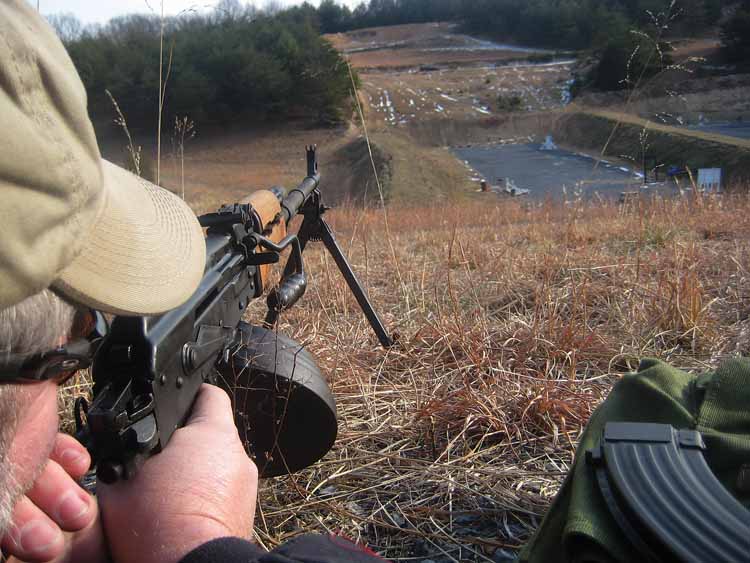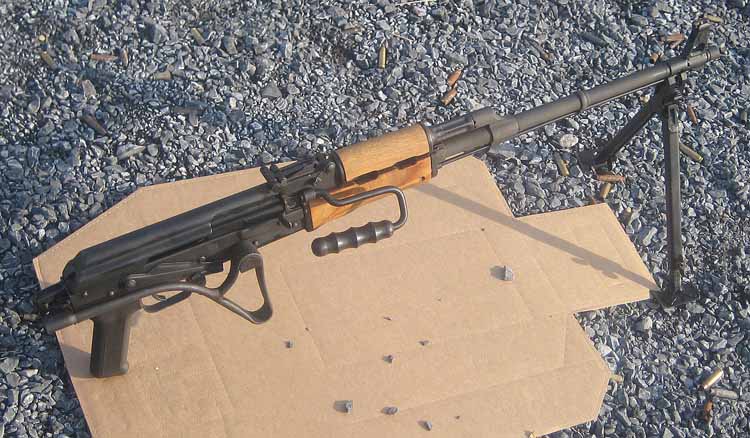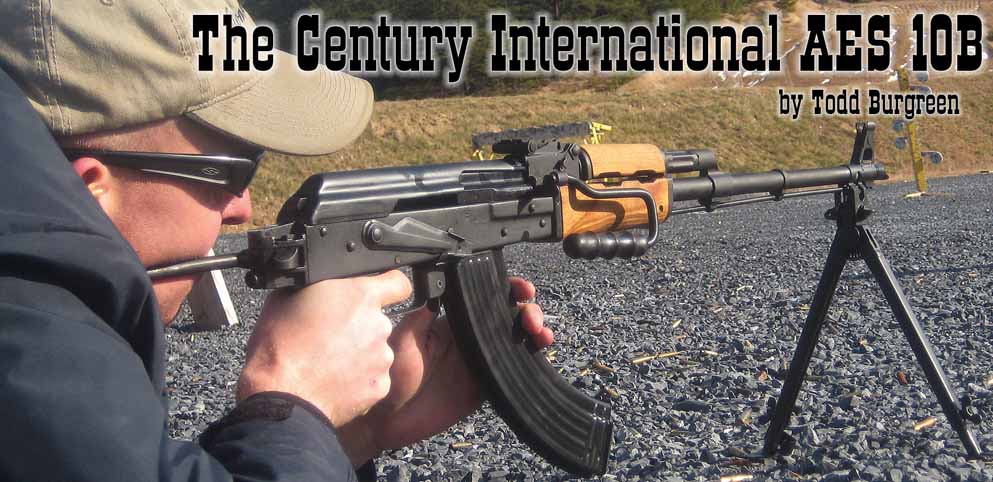It is a safe bet that everyone reading this magazine has been drawn by some inexorable force into considering a weapon that made no sense when one’s “needs” are analyzed empirically. Often times these firearms are sentimental favorites based on an affiliation with an original model not readily accessed. A recent phenomenon along these lines is represented by the Century International Arms semiautomatic AES-10B patterned after a Romanian version of the RPK light machine gun. The AK series of weapons are experiencing a renaissance/resurgence in popularity in the U.S. The AK’s association as the “enemy’s” weapon seems not to deter its growing popularity in the U.S. This stems from many factors: rugged reliability, price point, reasonably priced ammunition, an appreciation of 7.62×39 terminal ballistics, and the ever increasing quality and quantity of after-market parts.
The affinity toward AK platforms for many started with the affordable Romanian manufactured AKs arriving in the early 1990s, before the 1994 Assault Weapon Ban went into effect. While not aesthetically pleasing, ergonomic, or as inherently accurate as an AR, for many the AK was quickly turned into a “go to hell” rifle. A “go to hell” label translates into what rifle you would reach for when the world goes in the pot and you rush into your safe room looking for a rifle and pre-loaded magazines. The AK serves this role for many based on reliability no matter what field conditions it finds itself in. Smoking hand guards on an AK means it is only getting warmed up. Of course, this is an over simplification in the same vein that ARs are indeed more reliable than most give them credit for and AKs are more accurate.
The Century AES-10B RPK weighs approximately 12 pounds empty and the 23-inch 1:10 twist barrel lends to an overall length of 42 inches with wire stock unfolded and 34.25 inches folded. The wire folding stock is a unique AES-10B feature compared to most RPKs affixed with wooden stocks. The AES-10B’s wire stock comes with the added benefit that the rear trunnion is already configured to accommodate standard AK rear stocks. This is useful if an owner wants to switch out the rear stock to better suit their individual preferences unlike other semiautomatic RPK clones on the market. Most RPK clones are limited in this area fitted with either a “clubfoot” RPD-style stock or oversized AK wood stocks associated with Yugoslavian M72 versions of the RPK with no easy means available to switch out stocks unless the rear trunnion is modified. The AES-10B’s heavy barrel measures approximately 3/4 inches in diameter and is U.S. made sans chrome-lining. The U.S. made barrel contributes to the magical number of needed U.S. parts to pass BATF muster. The M14:1 LH threaded muzzle comes equipped with a slanted muzzle brake. The AES-10B RPK features an integral bipod that folds underneath the barrel until deployed. Research and observation indicates that the stamped receiver is reinforced and enlarged around the front trunnion connection to the barrel.
The RPK configured AES-10B differs from the typical AK/AKM in a number of design improvements intended to facilitate its role as a light machine gun. The barrel is lengthened and thickened to not only increase muzzle velocity, but also allow for increased heat capacity during extended fire sessions. Along these same lines the barrel is mated to a reinforced receiver housing reflective of its sustained fire role. 40-round stick and 75-round drum magazines were developed with the RPK to improve its combat rate of fire. The RPK was outfitted with folding bipod to stabilize it during deployment assisting a squad or platoon in advancing towards its objective or defending from an attack. The RPK rear sight is outfitted with sliding windage mechanism to improve fire accuracy and ease of adjustability. The original RPKs featured a rear stock identical to the Degtyarev RPD 44 machine gun. The interchangeability of parts between the RPK and AK/AKM is high including magazines.
As with most weapons adapted to suit a role beyond its original design intent the RPK has some drawbacks. The combination of firing from a closed bolt and fixed barrel translates into an operator having to use good fire discipline or the RPK will overheat and fail. Optimal sustained fire is around 80 rounds per minute. If overused, chambered rounds could “cook off;” not to mention barrel damage. The fixed barrel combined with inability to fire via belt fed ammunition cause many to question its utility as light machine gun. Comparisons to the U.S. BAR are common, though not necessarily accurate considering cartridges fired and different operating design ala closed bolt for RPK compared to open bolt for BAR. The RPK design commenced in the late 1950s and finalized by the Red Army in 1961, but did not enter wide-spread service until 1964. Each infantry squad was issued one RPK along with a 75-round drum magazine. The RPK continues in service in numerous post-Soviet countries and allies to this day with hundreds of thousands produced. The Kalashnikov’s gas piston operating system’s greatest benefit is reliability in more diverse environments due to reduced sensitivity to dirt and grime, not to mention the more powerful leverage it applies to the bolt compared to direct gas. Another key component is looser tolerances in the moving parts, giving it more latitude to function when dirty from field conditions or not cleaning after firing numerous rounds.

Century literature details an interesting story behind the AES-10B RPKs – though perhaps apocryphal. These rifles are the semiautomatic only version of the Romanian RPKs issued to elite paratrooper forces during the Communist Ceausescu Regime. The extremely rare AES-10B variant currently being offered is built using a small cache of rifles found in a sealed building in the Transylvanian factory town of Cugir. These were apparently to be issued for a planned massive troop build-up on the Romanian/Hungarian border when tensions flared between the two Warsaw Pact member states. Luckily, cooler heads prevailed and a crisis was averted. The rifles are identified by featuring a side folding stock, integral carry handle and bipod.
The Century AES-10B RPK was enjoyable to shoot at the range and amazingly effective in supplying firepower downrange. While not surprised at the lack of sub-MOA accuracy, it was very possible to hit man sized Mike Gibson Manufacturing (MGM) precision rifle targets placed at 200 and 300 yards. The prone position utilizing the integral bipod was predominately used for the evaluation; though standing and kneeling off hand positions were experimented with no problem even with 75-round drum magazines inserted. Fortunately, Echo Valley Training Center has installed two permanent “foxholes” created by turning large diameter concrete culvert pipes end wise into the ground complete with firing step in the bottom. Echo Valley Training Center features multi-stepped target berms that are strewn with reactive steel targets, fluid drained automobiles, and moving targets at ranges varying from 150 yards out to 350 yards. The protected firing positions were perfect for evaluating the AES-10B RPK in its intended fire support role. While certainly not comparable to a belt-fed switch barrel machine gun, a relatively large volume of fire was possible, especially when used with a high capacity 75-round drum with attention paid not to exceed 60 rounds per minute for any extended fire sessions. Two 40-round magazines come with AES-10B and standard 30-round AK magazines work fine as well.
The semiautomatic AES-10B firing the 7.62×39 cartridge is very controllable with its extra weight over the standard AK. In comparison to the RPK’s big brother, the PKM chambered in 7.62x54R, the RPK is a pleasure to shoot. The PKM medium machine gun is a handful compared to the semiautomatic RPK firing the intermediate 7.62×39. The wire folding stock did not prove problematic in terms of comfort or proper aiming with the AES-10B. Original thoughts of replacing the folding wire stock were shelved. At ranges under 400 yards one would not be considered terribly under-gunned with the AES-10B RPK semiautomatic. The car placed 200 yards away could not withstand the AES-10B fire. Rounds penetrated sheet metal, seats, or anything else in its path as the 7.62×39 easily passed through the car; only the wheel rims and engine block provided a modicum amount of resistance.

Multiple 7.62×39 loads were tested with the Century AES-10B such as Hornady, Wolf, Barnaul, Egyptian and Yugoslavian surplus. Barnaul Silver Bear zinc-plated and Wolf Ammunition steel cased 122gr and 124gr loads hovered in the 3 inch range at 100 yards with surplus Egyptian and Yugoslavian 7.62×39 producing similar groups. I found this acceptable considering my eyes and the non-target style battle sights that are found on the AES-10B. Unlike typical AK sights, the AES-10B’s rear sight was windage adjustable. The sights were right on out of the box. The G2 trigger was typically smooth and with reasonable pull weight measuring slightly over 5 lbs. The notorious AK trigger “slap” was present, but not all that distracting or painful if shooting gloves were used. No malfunctions were encountered in over 900 rounds fired during three range sessions while compiling this article. Interestingly, both the Egyptian and Yugoslavian surplus ammunition feature brass cases. One downside to the surplus ammunition is that it does utilize corrosive primers. Something the Russians and other ex-Soviet bloc states insisted on using due to concerns with cold weather ignition and long-term storage capabilities offered by corrosive primers. However, stocking up on it cannot be resisted considering that it can be still found at .25 cents a round or lower. Corrosive ammunition is not the destroyer of rifles many will lead you to believe as long as proper cleaning methods are followed to remove elements left over from the primer residue.
The long anticipated Hornady 123gr SST bullets mated to steel cases are starting to arrive on dealers’ shelves and were tested with the AES-10B. Seems that the original Hornady 7.62×39 loads that featured the V-Max bullet is being replaced with the SST bullet which represents a more controlled expansion with its bullet construction in lieu of the more varmint style V-Max construction. The SST loads delivered with accuracy in the 2 inch range at 100 yards. In all fairness, a magnified optic would have probably produced better accuracy results in lieu of the open sights, especially with the Hornady loads. The Century AES-10B comes equipped with a side rail scope base permitting the install of optics if desired and just not Com-bloc varieties with the advent of Picatinny-style side mounts. The thought of mounting a red dot or low magnification scope was toyed with ala what is being seen overseas on our troops M240/M249 weapons. The accuracy levels exhibited by the Hornady 123gr load added emphasis to this thought process, but was ultimately not employed. Gilt edge accuracy is not the goal with the AES-10B; it is a fighting rifle measured by a different set of parameters. Individuals will have to decide for themselves if the AES10B is worthy of a red dot or magnified optic.
Some will be attracted to the Century International Arms AES-1OB for its proven potential as a weapon, while others will find it the closest opportunity they will have to own a working replica of a historical firearm. It is very possible to state that the Century AES-10B was an enjoyable rifle to shoot and handle at the range. The AES-10B is an interesting piece of firearm development history that can still perform on the range.
SOURCES
Century International Arms
430 South Congress Ave. Suite 1
Delray Beach, FL 33445
(800) 527-1252
www.centuryarms.com
Echo Valley Training Center
www.echovalleytrainingcenter.com
Hornady Mfg. Inc.
3625 Old Potash Hwy
Grand Island, NE 68802
(800) 338-3220
www.hornady.com
Wolf Ammunition
PO Box 757
Placentia, CA 92871
(888) 757-9653
www.wolfammo.com
| This article first appeared in Small Arms Review V15N2 (November 2011) |











